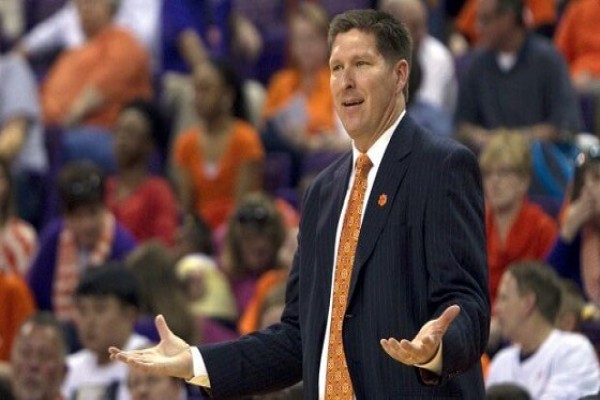New Year - New Start for Clemson
Coast To Coast : New Year - New Start for Clemson
Print

Clemson doesn’t have any home games this season.
Because the 48-year-old Littlejohn Coliseum is receiving a $63.5 million renovation, the Tigers are playing home games in Bon Secours Wellness Arena in Greenville, S.C., about a 55-minute drive from campus.
Their schedule for a weekend afternoon ‘home’ game is similar to their schedule for an ordinary road game. They ride a chartered bus to Greenville the day before and spend the night in a hotel. The next morning the Tigers hold a shootaround practice in the arena and head to the hotel afterward for two or three hours. They return to the arena two hours before tipoff.
It’s less than an ideal situation for coach Brad Brownell and the Tigers.
“It’s just the wear-and-tear of getting on the bus,” Brownell said. “Our practice situation is fine. We don’t have six goals (to use in practice), we have three usually for practice every day. It’s just small things that over the course of a long season when you’re spending a lot of time together, we’re spending even more time together. We’ve got to think of ways to keep this as fresh as possible.”
Then again, basketball success has never come easily or frequently at Clemson.
There are six remaining original members, who formed the ACC in 1954: Clemson, Duke, North Carolina, N.C. State, Virginia and Wake Forest. The Tigers are the only one without an ACC Tournament championship.
Clemson’s winning percentage against the five other original members (and Maryland which left the ACC in 2013) ranges from (.139) against North Carolina - who beat the Tigers for the 58th consecutive time in Chapel Hill recently - to (.418) against Virginia.
The Tigers last reached the Sweet 16 in 1997 and have a losing NCAA tournament record. The program has never produced a 2,000-point scorer. Elden Campbell, a large center with a soft touch, is Clemson’s career leader. He scored 1,881 points for the Tigers prior to his 15-year NBA career.
Climbing to the top of the ACC has become a steeper climb in recent seasons. For proof, look no further than the national championship banners hanging in Louisville’s KFC Yum! Center and Syracuse’s Carrier Dome. Or consider recent addition Notre Dame, which won the ACC Championship last season, beating Duke and North Carolina on consecutive days.
Brownell is in his sixth season at Clemson, after eight seasons at UNC Wilmington and Wright State where he had six 20-win seasons and three NCAA tournament appearances. At each stop, his teams have been built around toughness and defense. He took Clemson to the NCAA tournament in his first season, but the program’s 12th dance in March Madness has been elusive.
Still, he has the best winning percentage (.477) in conference games of any Clemson coach. That record is boosted by a surprising 3-1 start in ACC play that includes the loss to UNC and consecutive wins over three NCAA tournament caliber teams: Florida State, Syracuse and Louisville.
After a rocky ride through the nonconference schedule, Clemson is 10-6 overall.
“A lot of it is just confidence,” Brownell said. “We restarted after the (Christmas) break. Our highs were highs and our lows were lows early in the year.”
The Tigers spent most of November and December adjusting to life without point guard Rod Hall, a senior last season, who was a physical on-ball defender and more importantly, their floor leader.
“We probably did too many things individually, guys trying to do too much offensively and defensively, usually offensively,” Brownell said. “I don’t think it was selfishness or anything. I just think guys were trying to do too many things 1-on-1 instead of trusting what we’re doing, and understanding in difficult times we need to come together collectively and try to answer problems as a team.”
This is Brownell’s smallest team at Clemson from a height and weight perspective. Starting guards Avry Holmes and Jordan Roper are in the 6-foot neighborhood and slightly built. Jaron Blossomgame, the Tigers’ best player at 15.7 points and 7.0 rebounds per night, is a 6-7, 210 pound forward.
Their lack of size puts them at a disadvantage on defense. They’ve allowed 0.97 points per possession, easily the highest during Brownell’s tenure.
“We’ve played more zone at times,” Brownell said. “We have to make tweaks within game plans with certain guys to find ways to help them. We haven’t defended the way we traditionally defend. We’ve had to go away from a few things. Sometimes it’s been effective, sometimes it hasn’t. You have to constantly tweak what you’re doing. I like the guys we have, but we don’t have the prototypical size.”
Tightening up the defense will be imperative to survive their upcoming three-game stretch against Duke, Miami and Virginia. Each team has a top-15 offense per KenPom.com. But one factor working in Clemson’s favor has been its ability to avoid committing fouls as freedom of movement is emphasized this season. The Tigers have outscored opponents 227-159 at the free throw line.
“You’re constantly talking to your guys in practice about not fouling, about keeping hands off and moving your feet,” Brownell said. “We’re less physical than we used to be. It’s been a difference. We’ve done a pretty good job in most games in trying to guard as hard as we can without the handchecks and the holding. But we don’t have as many big, physical guys as we’ve had in the past.”
The recent wins have been promising. But life in the ACC this season is anything but enjoyable for those programs in the middle-of-the-pack. The league has six of the top 24 teams in the RPI, five of the top nine in KenPom ratings and four in the top 13 of the AP Top 25.
The fast start means Clemson can at least see the top of the standings. Maintaining that view will be a challenge for the Tigers in their season away from home.



